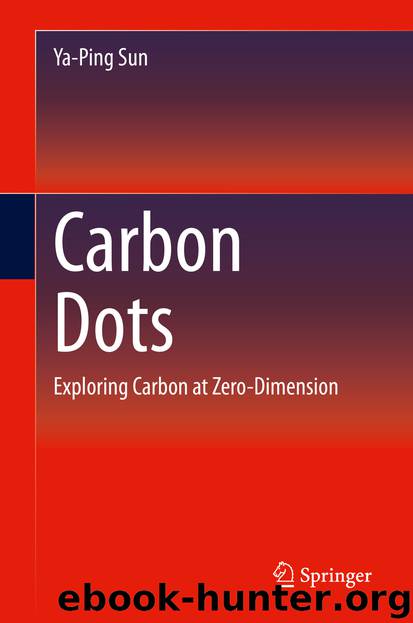Carbon Dots by Ya-Ping Sun

Author:Ya-Ping Sun
Language: eng
Format: epub
ISBN: 9783030411848
Publisher: Springer International Publishing
The functionalization of small carbon nanoparticles via the addition of organic radicals, for which the participation of the nanoparticles in radical copolymerization has provided strong corroborating evidence, may prove to be an extremely important finding in the continuing research and development of CDots.
6 Concluding Remarks
The two critical elements in the general definition of CDots are “carbon nanoparticles” and “passivation” of defects. For the classical synthesis based on pre-existing carbon nanoparticles, there are no major issues with the first. On the second among different passivation schemes, amidation chemistry has served the purpose of being simple and unambiguous for the functionalization, which coupled with de-functionalization provides a clear demonstration on the significance of passivation effects. Other modes of functionalization, especially the radical addition, offer some major advantages and should therefore be further developed.
CDots are characterized by their excellent optical and photoinduced redox properties, as emphasized in the chapter. Beyond that, however, CDots are also structurally flexible and versatile in terms of surface functionalities and conjugations with other species. There should be major opportunities in various combinations of all these characteristics.
The experimental results have been very consistent with the proposed/assumed mechanistic framework of CDots. However, the “physics” (quantum mechanistic elucidation) on why the passivated defects in the carbon nanomaterials would lead to the observed properties, including the details on structure–property correlations, remains an extremely important and apparently also extremely tough challenge. It might require new theoretical understandings in solid-state physics.
References Cited
Anilkumar, P., Wang, X., Cao, L., Sahu, S., Liu, J.-H., Wang, P., Korch, K., Tackett II, K.N., Parenzan, A., Sun, Y.-P.: Toward quantitatively fluorescent carbon-based “quantum” dots. Nanoscale. 3, 2023–2027 (2011)
Download
This site does not store any files on its server. We only index and link to content provided by other sites. Please contact the content providers to delete copyright contents if any and email us, we'll remove relevant links or contents immediately.
| Automotive | Engineering |
| Transportation |
Whiskies Galore by Ian Buxton(41937)
Introduction to Aircraft Design (Cambridge Aerospace Series) by John P. Fielding(33092)
Small Unmanned Fixed-wing Aircraft Design by Andrew J. Keane Andras Sobester James P. Scanlan & András Sóbester & James P. Scanlan(32763)
Craft Beer for the Homebrewer by Michael Agnew(18196)
Turbulence by E. J. Noyes(7977)
The Complete Stick Figure Physics Tutorials by Allen Sarah(7336)
Kaplan MCAT General Chemistry Review by Kaplan(6899)
The Thirst by Nesbo Jo(6877)
Bad Blood by John Carreyrou(6581)
Modelling of Convective Heat and Mass Transfer in Rotating Flows by Igor V. Shevchuk(6406)
Learning SQL by Alan Beaulieu(6237)
Weapons of Math Destruction by Cathy O'Neil(6214)
Man-made Catastrophes and Risk Information Concealment by Dmitry Chernov & Didier Sornette(5956)
Digital Minimalism by Cal Newport;(5704)
Life 3.0: Being Human in the Age of Artificial Intelligence by Tegmark Max(5512)
iGen by Jean M. Twenge(5384)
Secrets of Antigravity Propulsion: Tesla, UFOs, and Classified Aerospace Technology by Ph.D. Paul A. Laviolette(5332)
Design of Trajectory Optimization Approach for Space Maneuver Vehicle Skip Entry Problems by Runqi Chai & Al Savvaris & Antonios Tsourdos & Senchun Chai(5037)
Pale Blue Dot by Carl Sagan(4953)
